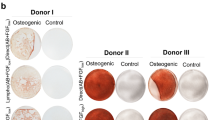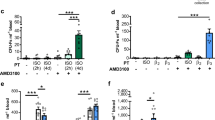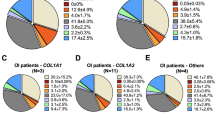Abstract
Osteonecrosis is a frequent complication after treatment for childhood leukemia and other steroid-based therapies. The success rate of core decompression surgery is limited. Therefore, we evaluated relevant biological characteristics of human multipotent mesenchymal stromal cells (MSCs) in vitro. MSCs cultured under low-oxygen tensions showed decreased proliferation and differentiation into bone. However, these MSCs secreted significant amounts of vascular endothelial-derived factor in the presence of interferon-γ. These in vitro results with potential effects on neovascularization and bone regeneration as well as findings in animal models prompted us to treat five patients with steroid-induced osteonecrosis of the femur by core decompression surgery and instillation of expanded autologous MSCs. Within 3 weeks of culture, sufficient numbers of MSCs were generated using animal protein-free culture conditions. No chromosomal aberrations were detected by matrix-based comparative genomic hybridization. Application of MSCs during core decompression was feasible and safe. Median follow-up is 16 months and the patients in this pilot study reported clinical improvement. Formation of mineralized bone in the osteonecrotic cavity was proven by computed tomography. Taken together, MSCs display biological properties that may add to the efficiency of surgical treatment in osteonecrosis and should be evaluated in larger patient cohorts.
This is a preview of subscription content, access via your institution
Access options
Subscribe to this journal
Receive 12 print issues and online access
$259.00 per year
only $21.58 per issue
Buy this article
- Purchase on Springer Link
- Instant access to full article PDF
Prices may be subject to local taxes which are calculated during checkout





Similar content being viewed by others
References
Burger B, Beier R, Zimmermann M, Beck JD, Reiter A, Schrappe M . Osteonecrosis: a treatment related toxicity in childhood acute lymphoblastic leukemia (ALL)—experiences from trial ALL-BFM 95. Pediatr Blood Cancer 2005; 44: 220–225.
Adekile AD, Gupta R, Yacoub F, Sinan T, Al-Bloushi M, Haider MZ . Avascular necrosis of the hip in children with sickle cell disease and high Hb F: magnetic resonance imaging findings and influence of alpha-thalassemia trait. Acta Haematol 2001; 105: 27–31.
Strauss AJ, Su JT, Dalton VM, Gelber RD, Sallan SE, Silverman LB . Bony morbidity in children treated for acute lymphoblastic leukemia. J Clin Oncol 2001; 19: 3066–3072.
Kobayakawa M, Rydholm U, Wingstrand H, Pettersson H, Lidgren L . Femoral head necrosis in juvenile chronic arthritis. Acta Orthop Scand 1989; 60: 164–169.
Steinberg ME, Steinberg DR . Classification systems for osteonecrosis: an overview. Orthop Clin North Am 2004; 35: 273-viii.
Karimova EJ, Rai SN, Deng X, Ingle DJ, Ralph AC, Neel MD et al. MRI of knee osteonecrosis in children with leukemia and lymphoma: part 1, observer agreement. AJR Am J Roentgenol 2006; 186: 470–476.
Karimova EJ, Rai SN, Ingle D, Ralph AC, Deng X, Neel MD et al. MRI of knee osteonecrosis in children with leukemia and lymphoma: part 2, clinical and imaging patterns. AJR Am J Roentgenol 2006; 186: 477–482.
Ribeiro RC, Fletcher BD, Kennedy W, Harrison PL, Neel MD, Kaste SC et al. Magnetic resonance imaging detection of avascular necrosis of the bone in children receiving intensive prednisone therapy for acute lymphoblastic leukemia or non-Hodgkin lymphoma. Leukemia 2001; 15: 891–897.
Castro Jr FP, Barrack RL . Core decompression and conservative treatment for avascular necrosis of the femoral head: a meta-analysis. Am J Orthop 2000; 29: 187–194.
Beltran J, Knight CT, Zuelzer WA, Morgan JP, Shwendeman LJ, Chandnani VP et al. Core decompression for avascular necrosis of the femoral head: correlation between long-term results and preoperative MR staging. Radiology 1990; 175: 533–536.
Low K, Mont MA, Hungerford DS . Steroid-associated osteonecrosis of the knee: a comprehensive review. Instr Course Lect 2001; 50: 489–493.
Simank HG, Brocai DR, Strauch K, Lukoschek M . Core decompression in osteonecrosis of the femoral head: risk-factor-dependent outcome evaluation using survivorship analysis. Int Orthop 1999; 23: 154–159.
Gangji V, Hauzeur JP, Matos C, Maertelaer De V, Toungouz M, Lambermont M . Treatment of osteonecrosis of the femoral head with implantation of autologous bone-marrow cells. A pilot study. J Bone Joint Surg Am 2004; 86-A: 1153–1160.
Hernigou P, Beaujean F . Treatment of osteonecrosis with autologous bone marrow grafting. Clin Orthop Relat Res 2002; 405: 14–23.
Yan ZQ, Chen YS, Li WJ, Yang Y, Huo JZ, Chen ZR et al. Treatment of osteonecrosis of the femoral head by percutaneous decompression and autologous bone marrow mononuclear cell infusion. Chin J Traumatol 2006; 9: 3–7.
Lee HS, Huang GT, Chiang H, Chiou LL, Chen MH, Hsieh CH et al. Multipotential mesenchymal stem cells from femoral bone marrow near the site of osteonecrosis. Stem Cells 2003; 21: 190–199.
Datta N, Holtorf HL, Sikavitsas VI, Jansen JA, Mikos AG . Effect of bone extracellular matrix synthesized in vitro on the osteoblastic differentiation of marrow stromal cells. Biomaterials 2005; 26: 971–977.
Kotobuki N, Hirose M, Machida H, Katou Y, Muraki K, Takakura Y et al. Viability and osteogenic potential of cryopreserved human bone marrow-derived mesenchymal cells. Tissue Eng 2005; 11: 663–673.
Kraus KH, Kirker-Head C . Mesenchymal stem cells and bone regeneration. Vet Surg 2006; 35: 232–242.
Hernigou P, Beaujean F, Lambotte JC . Decrease in the mesenchymal stem-cell pool in the proximal femur in corticosteroid-induced osteonecrosis. J Bone Joint Surg Br 1999; 81: 349–355.
Ikeguchi R, Kakinoki R, Aoyama T, Shibata KR, Otsuka S, Fukiage K et al. Regeneration of osteonecrosis of canine scapho-lunate using bone marrow stromal cells: possible therapeutic approach for Kienbock disease. Cell Transplant 2006; 15: 411–422.
Takahashi Y, Yamamoto M, Tabata Y . Osteogenic differentiation of mesenchymal stem cells in biodegradable sponges composed of gelatin and beta-tricalcium phosphate. Biomaterials 2005; 26: 3587–3596.
Wang Z, Goh J, Das DS, Ge Z, Ouyang H, Chong JS et al. Efficacy of bone marrow-derived stem cells in strengthening osteoporotic bone in a rabbit model. Tissue Eng 2006; 12: 1753–1761.
Horwitz EM, Gordon PL, Koo WK, Marx JC, Neel MD, McNall RY et al. Isolated allogeneic bone marrow-derived mesenchymal cells engraft and stimulate growth in children with osteogenesis imperfecta: implications for cell therapy of bone. Proc Natl Acad Sci USA 2002; 99: 8932–8937.
Le Blanc K, Gotherstrom C, Ringden O, Hassan M, McMahon R, Horwitz E et al. Fetal mesenchymal stem-cell engraftment in bone after in utero transplantation in a patient with severe osteogenesis imperfecta. Transplantation 2005; 79: 1607–1614.
Phinney DG, Prockop DJ . Concise review: mesenchymal stem/multipotent stromal cells: the state of transdifferentiation and modes of tissue repair—current views. Stem Cells 2007; 25: 2896–2902.
Solinas-Toldo S, Lampel S, Stilgenbauer S, Nickolenko J, Benner A, Dohner H et al. Matrix-based comparative genomic hybridization: biochips to screen for genomic imbalances. Genes Chromosomes Cancer 1997; 20: 399–407.
Mendrzyk F, Radlwimmer B, Joos S, Kokocinski F, Benner A, Stange DE et al. Genomic and protein expression profiling identifies CDK6 as novel independent prognostic marker in medulloblastoma. J Clin Oncol 2005; 23: 8853–8862.
Pfister S, Remke M, Toedt G, Werft W, Benner A, Mendrzyk F et al. Supratentorial primitive neuroectodermal tumors of the central nervous system frequently harbor deletions of the CDKN2A locus and other genomic aberrations distinct from medulloblastomas. Genes Chromosomes Cancer 2007; 46: 839–851.
Maegawa N, Kawamura K, Hirose M, Yajima H, Takakura Y, Ohgushi H . Enhancement of osteoblastic differentiation of mesenchymal stromal cells cultured by selective combination of bone morphogenetic protein-2 (BMP-2) and fibroblast growth factor-2 (FGF-2). J Tissue Eng Regen Med 2007; 1: 306–313.
Okuyama H, Krishnamachary B, Zhou YF, Nagasawa H, Bosch-Marce M, Semenza GL . Expression of vascular endothelial growth factor receptor 1 in bone marrow-derived mesenchymal cells is dependent on hypoxia-inducible factor 1. J Biol Chem 2006; 281: 15554–15563.
Müller I, Kordowich S, Holzwarth C, Spano C, Isensee G, Staiber A et al. Animal serum-free culture conditions for isolation and expansion of multipotent mesenchymal stromal cells from human BM. Cytotherapy 2006; 8: 437–444.
Fibbe WE, Nauta AJ, Roelofs H . Modulation of immune responses by mesenchymal stem cells. Ann NY Acad Sci 2007; 1106: 272–278.
Le Blanc K, Ringden O . Mesenchymal stem cells: properties and role in clinical bone marrow transplantation. Curr Opin Immunol 2006; 18: 586–591.
Müller I, Kordowich S, Holzwarth C, Isensee G, Lang P, Neunhoeffer F et al. Application of multipotent mesenchymal stromal cells in pediatric patients following allogeneic stem cell transplantation. Blood Cells Mol Dis 2008; 40: 25–32.
Lazarus HM, Koc ON, Devine SM, Curtin P, Maziarz RT, Holland HK et al. Cotransplantation of HLA-identical sibling culture-expanded mesenchymal stem cells and hematopoietic stem cells in hematologic malignancy patients. Biol Blood Marrow Transplant 2005; 11: 389–398.
Dickhut A, Schwerdtfeger R, Kuklick L, Ritter M, Thiede C, Neubauer A et al. Mesenchymal stem cells obtained after bone marrow transplantation or peripheral blood stem cell transplantation originate from host tissue. Ann Hematol 2005; 84: 722–727.
Koc ON, Peters C, Aubourg P, Raghavan S, Dyhouse S, DeGasperi R et al. Bone marrow-derived mesenchymal stem cells remain host-derived despite successful hematopoietic engraftment after allogeneic transplantation in patients with lysosomal and peroxisomal storage diseases. Exp Hematol 1999; 27: 1675–1681.
Poloni A, Leoni P, Buscemi L, Balducci F, Pasquini R, Masia MC et al. Engraftment capacity of mesenchymal cells following hematopoietic stem cell transplantation in patients receiving reduced-intensity conditioning regimen. Leukemia 2006; 20: 329–335.
Pozzi S, Lisini D, Podesta M, Bernardo ME, Sessarego N, Piaggio G et al. Donor multipotent mesenchymal stromal cells may engraft in pediatric patients given either cord blood or bone marrow transplantation. Exp Hematol 2006; 34: 934–942.
Liechty KW, MacKenzie TC, Shaaban AF, Radu A, Moseley AM, Deans R et al. Human mesenchymal stem cells engraft and demonstrate site-specific differentiation after in utero transplantation in sheep. Nat Med 2000; 6: 1282–1286.
Meyerrose TE, De Ugarte DA, Hofling AA, Herrbrich PE, Cordonnier TD, Shultz LD et al. In vivo distribution of human adipose-derived mesenchymal stem cells in novel xenotransplantation models. Stem Cells 2007; 25: 220–227.
Caplan AI, Dennis JE . Mesenchymal stem cells as trophic mediators. J Cell Biochem 2006; 98: 1076–1084.
Noiseux N, Gnecchi M, Lopez-Ilasaca M, Zhang L, Solomon SD, Deb A et al. Mesenchymal stem cells overexpressing Akt dramatically repair infarcted myocardium and improve cardiac function despite infrequent cellular fusion or differentiation. Mol Ther 2006; 14: 840–850.
Hung SC, Pochampally RR, Chen SC, Hsu SC, Prockop DJ . Angiogenic effects of human multipotent stromal cell onditioned medium activate the PI3K–Akt pathway in hypoxic endothelial cells to inhibit apoptosis, increase survival, and stimulate angiogenesis. Stem Cells 2007; 25: 2363–2370.
Conover C . Insulin-like growth factor binding proteins and bone metabolism. Am J Physiol Endocrinol Metab 2007; 294: 10–14.
Kaku K, Osada H, Seki K, Sekiya S . Insulin-like growth factor 2 (IGF2) and IGF2 receptor gene variants are associated with fetal growth. Acta Paediatr 2007; 96: 363–367.
Boudignon BM, Bikle DD, Kurimoto P, Elalieh H, Nishida S, Wang Y et al. Insulin-like growth factor I stimulates recovery of bone lost after a period of skeletal unloading. J Appl Physiol 2007; 103: 125–131.
Serakinci N, Guldberg P, Burns JS, Abdallah B, Schrodder H, Jensen T et al. Adult human mesenchymal stem cell as a target for neoplastic transformation. Oncogene 2004; 23: 5095–5098.
Wang Y, Huso DL, Harrington J, Kellner J, Jeong DK, Turney J et al. Outgrowth of a transformed cell population derived from normal human BM mesenchymal stem cell culture. Cytotherapy 2005; 7: 509–519.
Author information
Authors and Affiliations
Corresponding author
Rights and permissions
About this article
Cite this article
Müller, I., Vaegler, M., Holzwarth, C. et al. Secretion of angiogenic proteins by human multipotent mesenchymal stromal cells and their clinical potential in the treatment of avascular osteonecrosis. Leukemia 22, 2054–2061 (2008). https://doi.org/10.1038/leu.2008.217
Received:
Revised:
Accepted:
Published:
Issue Date:
DOI: https://doi.org/10.1038/leu.2008.217
Keywords
This article is cited by
-
Expression of HLA-DR by mesenchymal stromal cells in the platelet lysate era: an obsolete release criterion for MSCs?
Journal of Translational Medicine (2024)
-
Emerging role of mesenchymal stem/stromal cells (MSCs) and MSCs-derived exosomes in bone- and joint-associated musculoskeletal disorders: a new frontier
European Journal of Medical Research (2023)
-
Mesenchymal stromal cells for osteonecrosis
Journal of Translational Medicine (2020)
-
Outcome of childhood leukaemia survivors and necrosis of the femoral head treated with autologous mesenchymal stem cells
Clinical and Translational Oncology (2018)
-
Focused extracorporeal shock wave for osteonecrosis of the femoral head with leukemia after allo-HSCT: a case series
Bone Marrow Transplantation (2016)



